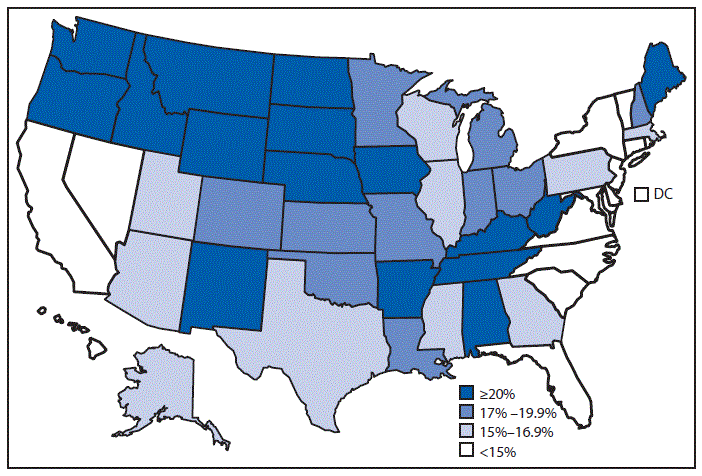QuickStats: Percentage of Adults Aged ≥18 Years with Any Hearing Loss,* by State — National Health Interview Survey,† 2014–2016
Weekly / December 22, 2017 / 66(50);1389

* Based on a survey question that asked respondents, “Without the use of hearing aids or other listening devices, is your hearing excellent, good, have a little trouble hearing, moderate trouble, a lot of trouble, or are you deaf?” “A little trouble hearing,” “moderate trouble,” “a lot of trouble,” and “deaf” were combined for this chart.
† Estimates are based on household interviews of a sample of the civilian, noninstitutionalized U.S. adult population and are shown for sample adults aged ≥18 years.
Overall, 15.9% of U.S. adults aged ≥18 years had any hearing loss during 2014–2016. The prevalence of any hearing loss was lowest in New Jersey (10.6%), Connecticut (11.0%), Maryland (11.0%), California (12.3%), New York (12.6%), and the District of Columbia (8.6%). The prevalence of any hearing loss was highest in West Virginia (24.7%), Oregon (24.6%), Montana (23.8%), Idaho (23.1%), and Wyoming (22.3%).
Source: National Health Interview Survey, 2014-2016. Survey data available at https://www.cdc.gov/nchs/nhis/data-questionnaires-documentation.htm. Tabular results available at https://www.cdc.gov/nchs/data/health_policy/hearing_loss_table_SEs.pdfpdf icon.
Reported by: Debra L. Blackwell, PhD, DBlackwell@cdc.gov, 301-458-4103; Tina Norris, PhD.
Suggested citation for this article: QuickStats: Percentage of Adults Aged ≥18 Years with Any Hearing Loss, by State — National Health Interview Survey,2014–2016. MMWR Morb Mortal Wkly Rep 2017;66:1389. DOI: http://dx.doi.org/10.15585/mmwr.mm6650a7external icon.
MMWR and Morbidity and Mortality Weekly Report are service marks of the U.S. Department of Health and Human Services.
Use of trade names and commercial sources is for identification only and does not imply endorsement by the U.S. Department of
Health and Human Services.
References to non-CDC sites on the Internet are
provided as a service to MMWR readers and do not constitute or imply
endorsement of these organizations or their programs by CDC or the U.S.
Department of Health and Human Services. CDC is not responsible for the content
of pages found at these sites. URL addresses listed in MMWR were current as of
the date of publication.
All HTML versions of MMWR articles are generated from final proofs through an automated process. This conversion might result in character translation or format errors in the HTML version. Users are referred to the electronic PDF version (https://www.cdc.gov/mmwr) and/or the original MMWR paper copy for printable versions of official text, figures, and tables.
Questions or messages regarding errors in formatting should be addressed to mmwrq@cdc.gov.